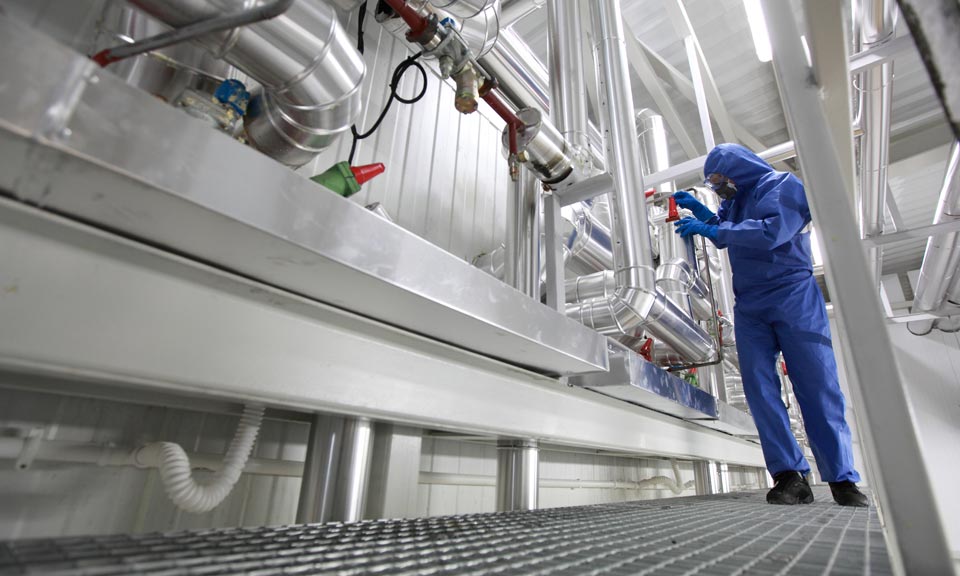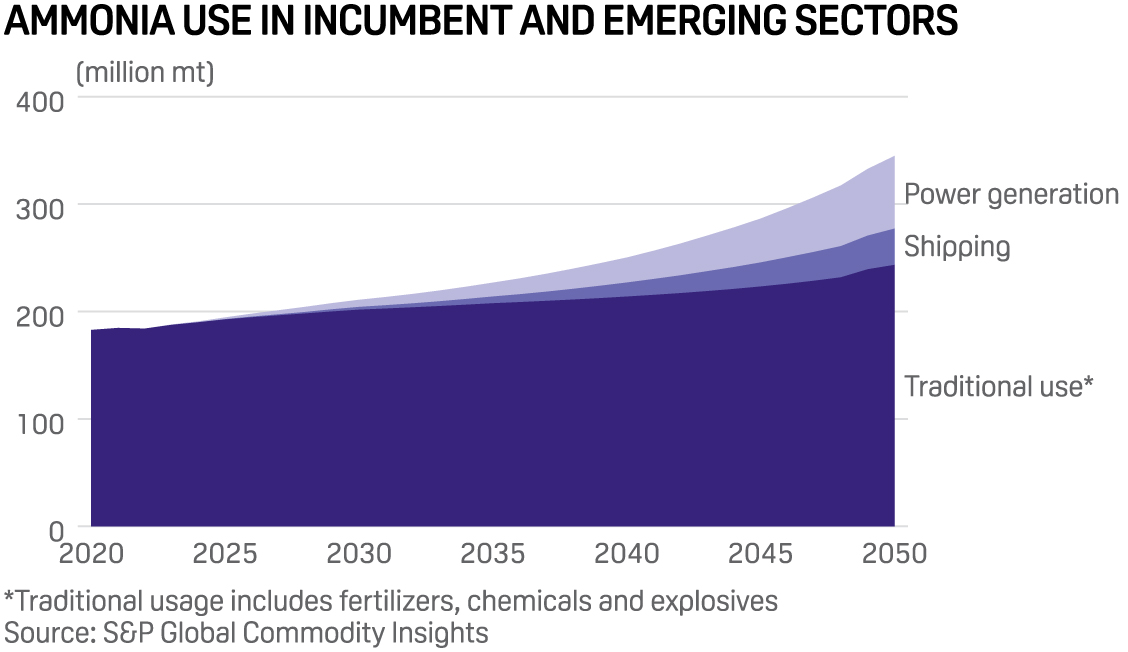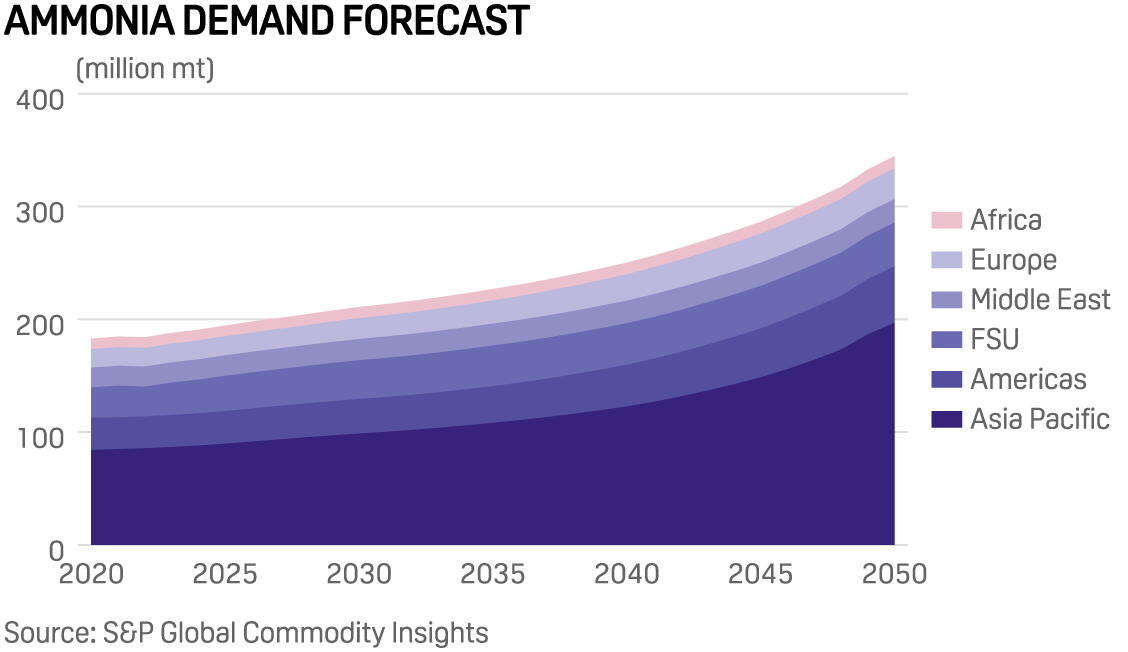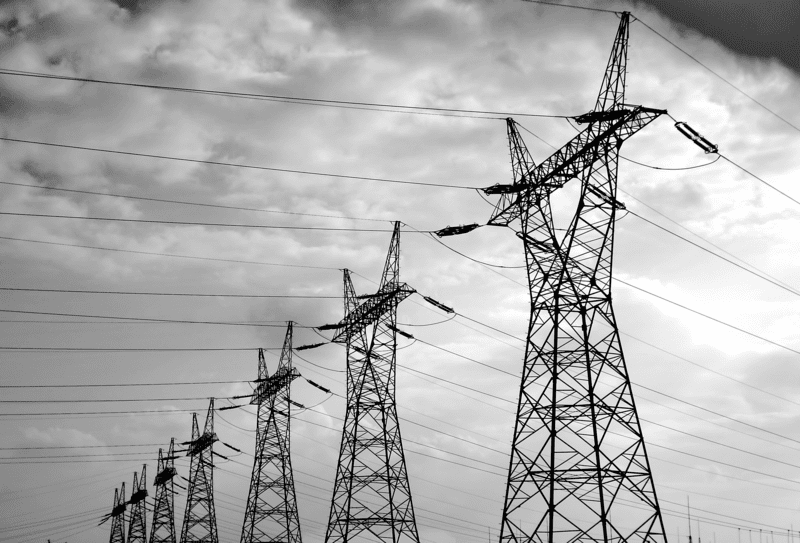Unpacking ammonia’s market landscape and its role in the energy transition

The surge in natural gas feedstocks costs in Europe in mid-2021 and the ongoing war between Russia and Ukraine boosted global ammonia spot prices to historic highs in April. For most of 2022 prices have been triple or quadruple the levels seen between 2016 and 2020.
The abrupt stop of Russian and Ukrainian ammonia shipments out of the Black Sea after the Russian invasion of Ukraine in February slashed global supplies. Russian ammonia had previously been transported via a pipeline from Togliatti to the Ukrainian Black Sea port of Yuzhne, which had turned the Black Sea into a major ammonia benchmark. Russia and Ukraine had a combined market share of around 20% in global ammonia exports before the war.
Meanwhile, record high natural gas feedstock costs in Europe forced ammonia producers in the region to lower operating rates or shut down altogether. This in turn led to a surge in additional demand in Europe for ammonia from around the globe, including from the Caribbean, Middle East and as far afield as Southeast Asia.
Just as there have been dramatic changes on the supply side, the demand side is also gearing up for ammonia's use as a fuel in the years to come.
Ammonia has traditionally been used in fertilizers, with nearly 90% of the product supporting agriculture around the world. It has also found usage in chemicals such as caprolactam, the feedstock for nylon, and acrylonitrile, the feedstock for acrylic fiber. It is also a feedstock for explosives used in mining.
Ammonia's chemical composition – each molecule has one nitrogen and three hydrogen atoms – makes it a key candidate to become a carrier for hydrogen, while decarbonization goals have made it a target for production as well.
Ammonia is relatively easy to transport – this has been technologically and commercially proven for decades. The infrastructure for producing and transporting liquified hydrogen, on the other hand, is still in its infancy and it could take many years before the business is commercially viable, and up and running globally. The key hurdle for hydrogen is the extreme low temperature needed for liquefaction at -253 C, while for ammonia the requirement is only -33 C.
Another driver behind ammonia's popularity is the emergence of end-users with decarbonization goals. These end-users plan to use ammonia produced from low-carbon or zero-carbon hydrogen as a fuel for power generation and bunkering. Ammonia itself does not release carbons on combustion.

Massive investments are now taking place or are being considered, which will change the ammonia landscape dramatically in the years ahead, according to data from S&P Global Commodity Insights. Demand from the power sector and bunkering for ammonia, currently not measurable as the volumes are too small, will see its share in total ammonia demand rising to around 4% in 2030, and to around 29% in 2050.
Asia is expected to be a key driver in the increasing demand for ammonia as an energy transition fuel.
Consider, for instance, the goals of the Japanese government: the Ministry of Economy, Trade and Industry estimates that Japan's ammonia demand for power generation would be 3 million mt/year in 2030, will grow to 30 million mt/year in 2050. Ammonia is needed in Japan to be able to decarbonize gradually given the amount of existing coal-fired power plants there, as it can be used for co-firing.

Platts, part of S&P Global Commodity Insights, launched the world's first prices and premiums for low-carbon blue ammonia on April 22, with daily assessments for the Middle East, Far East Asia, Northwest Europe and the US Gulf as a first step into ammonia assessments related to the energy transition. Blue ammonia is a low-carbon ammonia produced conventionally using gas as feedstock, but where most carbons produced in the process are being captured and sequestrated. S&P Global defines blue ammonia as ammonia with a carbon capture rate of 90%.
On Sept. 16, S&P Global is expanding its portfolio of global Platts forward curves for ammonia to 24 months, building on top of the current Platts ammonia forward curves offerings. The launch is a response to an increased interest for longer-term ammonia price trends, amid unprecedented volatility and historically high ammonia spot prices seen this year.
News
Moment of truth looms for European green hydrogen investments Energy transition highlights: Our editors and analysts bring you the biggest stories from the industry this week, from renewables to storage to carbon prices. Time is running out to get on track with Europe's ambitious 2030 hydrogen production targets as developers due to take final investment decisions battle macroeconomic headwinds, industry representatives said at the Reuters Hydrogen conference in Amsterdam. Recent years have seen a multitude of project announcements, pre-front end engineering design studies, FEED studies and preliminary investments, though FIDs have been scarce. “There are some board rooms that are getting a little bit impatient by now,” Rabobank Executive Director Hyung-ja de Zeeuw said April 9. “If you think that we’ve only got six years left until 2030, I guess 2024 is going to be a key year for clean hydrogen projects here in Europe.” Around 4% of announced clean hydrogen projects in Europe have taken FIDs, according to Hydrogen Council Director Policy and Partnerships Daria Nochevnik. Price of the week: Eur4.50/kg The price ceiling for the first pilot auction under the European Hydrogen Bank mechanism. Results will be announced April 30, with the fund expected to clear well below the cap. Editor’s pick: Premium and free content SPGlobal.com Biden's carbon capture plans inch closer to reality amid uptick in well permits The Biden administration's ambition to capture carbon dioxide on a large scale and inject it back into the ground may have seemed daunting one year ago with only two CO2 storage facilities in the US. But a boost in federal spending on the technology in 2021 and 2022 may finally be bearing fruit after a sudden uptick in permits, according to industry watchers. Australia to unveil new plan for clean energy, green manufacturing: PM Australia will unveil a new plan in 2024 to support clean energy and green manufacturing projects to compete better against other nations’ subsidy schemes such as the US’ Inflation Reduction Act to draw investments in clean fuels, Prime Minister Anthony Albanese said, in what is being seeing as a pointer to big new fund allocations coming up. Escalating geopolitical tensions may give carbon market a key role to play: GenZero Carbon markets will be most critical in a scenario where global climate action is fragmented and geopolitical tensions are at their highest, as opposed to a scenario of full climate cooperation where carbon markets are least needed, Singapore’s state-owned decarbonization investment platform GenZero said. Platts Connect European Hydrogen Bank pilot auction to clear well below Eur4.50/kg price ceiling The first pilot auction for green hydrogen production under the EU’s European Hydrogen Bank facility will clear comfortably below the price ceiling of Eur4.50/kg ($4.89/kg), Innovation Fund policy officer Johanna Schiele said April 10. The results of the first Eur800 million auction will be released on April 30, Schiele said. Hydrogen market developing in New York; regulatory, power market challenges remain Using hydrogen to generate power in New York does not currently add up economically, but there is reason for optimism as the technology to do so will likely be needed in some capacity to help meet state decarbonization goals, experts said. China’s CEIC starts construction of 100,000 mt/year capacity green ammonia project China Energy Investment Corporation, one of the country’s largest state-owned energy companies, has started construction of its renewable ammonia project in Cangzhou in the eastern province of Hebei with a planned annual production capacity of 100,000 mt, likely to be completed by Q4 2025.
News
JERA signs deal with CF Industries to develop 1.4 mil mt/year US ammonia project by 2028 Energy transition highlights: Our editors and analysts bring you the biggest stories from the industry this week, from renewables to storage to carbon prices. Japan's largest power generation company, JERA has agreed with US-based CF Industries to explore the development of a 1.4 million mt/year low-carbon ammonia project at the latter's Blue Point Complex in Louisiana, with the plan to start production in 2028. Under a joint development agreement, JERA is considering taking a 48% stake in the project as well as procuring more than 500,000 mt/year of ammonia to meet low carbon fuel demand in Japan. JERA and CF Industries aim to make a final investment decision "within a year" for the project, which will capture CO2 from production and use it for carbon capture and storage, according to a JERA spokesperson. JERA has pledged to commercialize its ammonia co-firing power generation by 2030 as part of its aim to start using 100% ammonia as fuel in the 2040s for its 2050 carbon neutrality target. Platts, a part of S&P Global Commodity Insights, assessed NSW hydrogen produced via alkaline electrolysis at $3.08/kg on April 19, up 33% on the month. It assessed Japan hydrogen produced via alkaline electrolysis at $2.56/kg on April 19, down 42% on the month. SPGlobal.com Uniper delays Rotterdam hydrogen plant amid high grid fees, lack of offtake certainty Uniper has pushed back the startup of the first 100-MW phase of its planned H2Maasvlakte green hydrogen plant in Rotterdam, the Netherlands, after failing to secure a power purchase agreement for the facility, and amid high grid fees and uncertainty over sufficient offtake interest. China kicks off consultation for compliance emission trading rules in 2024-2025 China, the world's largest compliance carbon market by emission volumes covered, has kicked off an internal consultation for the compliance emission trading rules to be implemented in 2024-2025 among power companies, according to a consultation document seen by S&P Global Commodity Insights. Platts Connect Woodside aims for renewable hydrogen supply in Western Australia in 2025 Woodside Energy, that is developing clean hydrogen/ammonia projects in Australia and the US, is targeting supply of renewable hydrogen in Western Australia for industrial and transport customers from its H2Perth refueling project in 2025. Detailed engineering, construction, commissioning and start-up work scopes have been awarded. Twenty-five US states launch legal challenge to Biden tailpipe emissions rule Twenty-five Republican-led states sued the United States Environmental Protection Agency April 18, hoping to block a new EPA rule designed to limit car tailpipe emissions and advance the Biden administration's push for electric vehicle adoption.
News
US Solar eclipse expected to significantly reduce solar power output in several markets Energy transition highlights: Our editors and analysts bring together everything you need to know about the industry this week, from renewables to storage to carbon prices. A total solar eclipse will cross North America on April 8, passing over Mexico, the US and Canada, causing significant reductions in solar power plant output with the greatest impacts occurring in the Electric Reliability Council of Texas and PJM Interconnection power markets. An annular eclipse obscures most of the sun except for a halo of sunlight around the edge of the moon’s dark disc, while during a total eclipse the entirety of the sun will be blocked by the moon. In Dallas, the partial eclipse will begin at 12:23 pm CT, with maximum totality occurring at 1:42 pm and the partial eclipse will end at 3:02 pm, according to the National Aeronautics and Space Administration. Maximum totality will reach Cleveland at 3:15 pm ET, Buffalo at 3:20 pm, and Caribou, Maine at 3:33 pm. Solar power production in ERCOT is expected to drop to 3 GW generated during the hour of totality versus the roughly 18 GW that is usually generated during that same time of day on a clear sky day in April, according to Maxar Technologies, an advanced forecasting company that provides data to US power grid operators. As the moon’s shadow moves north through the PJM footprint, solar power output is expected to drop to around 1.6 GW during the hour of totality compared with roughly 7GW on a clear sky day in April, a Maxar spokesperson said in an email. Even under cloudy skies, PJM is preparing for temporary losses of at least 80% to 85% of the production from the approximately 8.2 GW of grid-connected solar or metered solar resources that are part of the PJM solar generation fleet in early April, the grid operator said in a media release. Price of the week: On the Intercontinental Exchange during April 5 trading, ERCOT North Hub day-ahead on-peak rose about $17.50 from its previous settlement to $27/MWh and its corresponding real-time peak contract jumped about $19 to around $29.50/MWh for April 8 delivery. Editor’s pick: Premium and free content SPGlobal.com INTERVIEW: Building a credible carbon market takes time; 'bear with us', says ICVCM A step-by-step approach to informing the market about which project methodologies meet high-quality carbon credit thresholds is considered the best way forward given the high number of methodologies involved, the Integrity Council for the Voluntary Carbon Market said. The ICVCM confirmed that carbon credit programs from American Carbon Registry, Climate Action Reserve and Gold Standard had met its high-quality Core Carbon Principle labels. China kicks off consultation on expanding compliance carbon market to cement sector China has kicked off public consultation on drafting guidelines around emissions accounting and verification for the country's cement sector, laying the foundation for its inclusion in the national compliance carbon market, the Ministry of Ecology and Environment said in a notice late April 3. Thailand's Bangchak, Japan's Sumitomo join forces for green UCO-to-SAF supply chain Thailand-based energy firm Bangchak and Japan's Sumitomo Corp. have signed a cooperative framework agreement for the procurement of used cooking oil and the sale of sustainable aviation fuel, the companies said in an April 3 joint release. Platts Connect Denmark paves way for hydrogen pipeline exporting surplus wind to Germany Denmark is paving the way for state financing for the Jutland hydrogen backbone pipeline to export surplus wind power to Germany, the energy ministry said. Political parties agreed five framework conditions that need to be met for grid operator Energinet to go-ahead with the project including a 1.4-GW or 44% of total capacity booking requirement by private companies. China’s domestic renewable energy certificate trade volume up tenfold in 2023 The annual trading volume of China’s domestic renewable energy certificates, called Green Electricity Certificates, increased almost tenfold to 96 million certificates in 2023, a record high for a year, from 9.69 million certificates in 2022, data from the country’s GEC trading platform showed. Fortescue misses FID date for key renewable hydrogen project under Genex PPA Fortescue Future Industry has missed the deadline for final investment decision (FID) for a key renewable hydrogen/ammonia project in Australia, thus failing to meet a buyer’s condition in a Power Purchase Agreement (PPA) with Genex Power, Genex said April 2.

News
A total solar eclipse will cross North America on April 8, resulting in heavily reduced solar power plant output. It will differ from an annular eclipse in that the sun will be entirely blocked by the moon, rather than partially blocked with a visible halo of sunlight. Power markets in Texas and the Mid-Atlantic region are expected to see the biggest impact in solar-powered generation. Related feature: US solar eclipse expected to significantly reduce solar power output in several markets (subscriber content) Click here for the full-size infographic